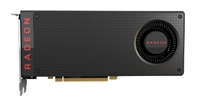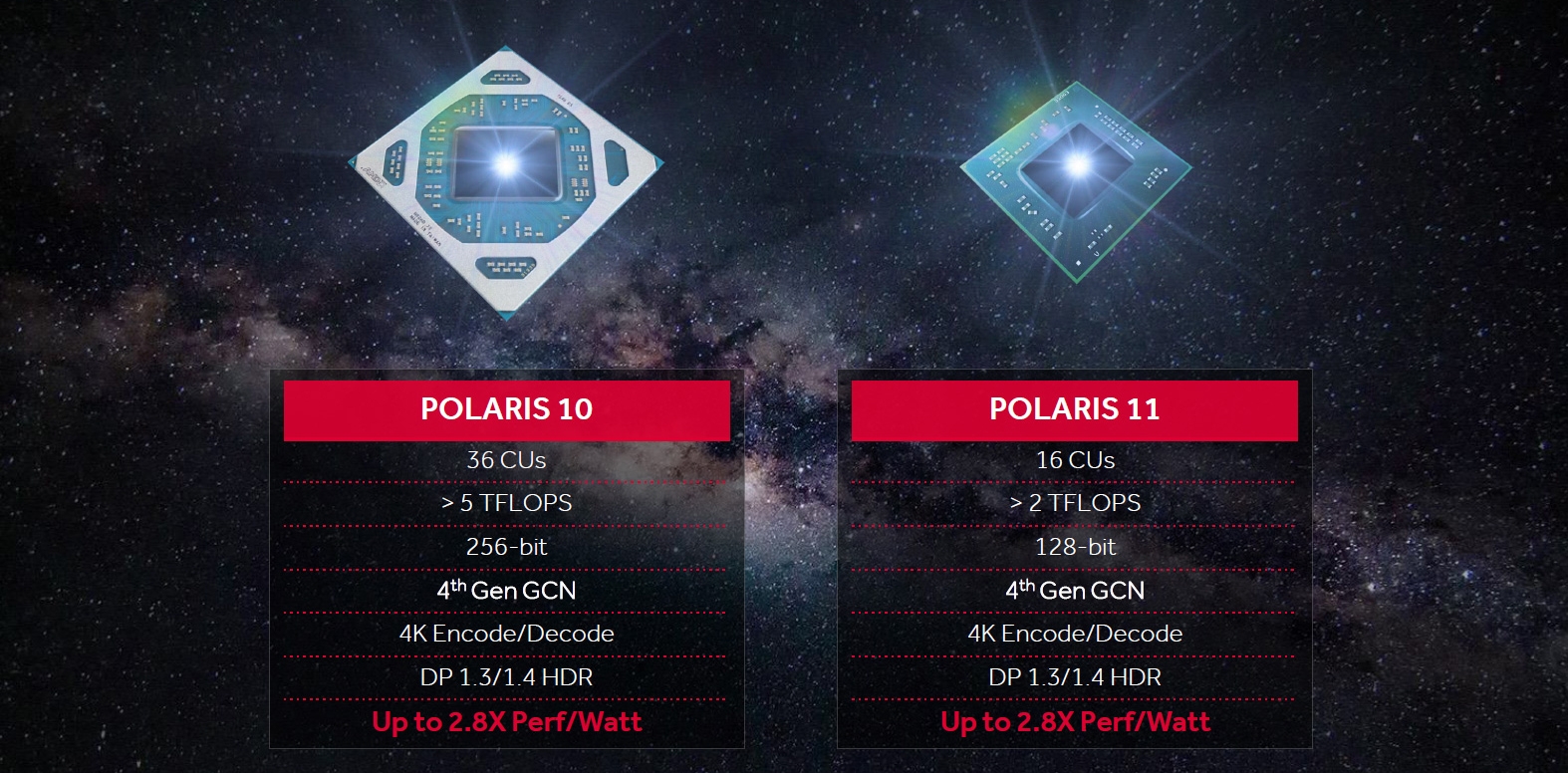.jpg?format=webp)
AMD Radeon RX 460 and Radeon RX 470
While there have been many recent releases of some major power and highly priced GPUs, the graphics card market is still emerging with new technology such as AMD's Polaris-based graphics cards. The company just released its Radeon RX 460 and RX 470 cards, both based on AMD's new Polaris chip architecture. The Radeon RX 460 features AMD's Polaris 11 which is said to have wattage under 50W and is aimed at the notebook and small form factor market. The latter Radeon RX 470 uses AMD's Polaris 10 Pro which is known to be the flagship chip based on the GCN 4.0 architecture. AMD Polaris 10-based cards are aimed at both mainstream and desktop builds, while staying competitive in terms of performance and efficiency.
The Radeon RX 470 and 460 cards are targeted towards consumer gamers and offer budget alternatives to more expensive GPU options currently on the market. They not only deliver great performance increases over their previous iterations, but are designed with power efficiency in mind.
Let’s take a look at the numbers:
AMD Radeon RX 460 
| AMD Radeon RX 470 
| AMD Radeon RX 480 .jpg)
| |
Graphics Core | Polaris 11 | Polaris 10 Pro | Polaris 10 XT |
Stream Processors | 896 SPs | 2048 SPs | 2304 SPs |
Clock Frequency | 1200 MHz | 1206 MHz | 1266 MHz |
Compute Performance | 2.2 TFLOPs | 4.9 TFLOPs | 5.8 TFLOPs |
VRAM | 2/4 GB GDDR5 | 4 GB GDDR5 | 4/8 GB GDDR5 |
Bus Interface | 128-bit | 256-bit | 256-bit |
Memory Speed | 7 GHz | 6.6 GHz | 8 GHz |
Memory Bandwidth | 112 GB/s | 211 GB/s | 256 GB/s |
TDP | < 75W | 120W | 150W |
The Radeon RX 470 comes with 2048 stream processors with a fast clock speed of 1206 MHz. It is slightly less powerful than AMD's higher end Polaris model, the Radeon RX 480. With 2304 stream processors, 5.8 TFLOPS, and 4 or 8 GB GDDR5 VRAM, the RX 480 is clearly built for those who want top notch HD experience with VR capabilities. However, the RX 470 is not too far off in terms of performance. With a little light overclocking, you will be able to get almost the same gaming performance from the RX 470 compared to a stock-clocked RX 480. Capable of displays at 1080p, AMD chose to keep this card to a 4GB memory variant in order to keep costs low. It is suited for playing the most popular games currently on the market at 60 FPS+ on high settings and 1080p making it an all around top performer GPU in its class and cost. The RX 470 will be able to deliver the same resolutions as the more powerful RX 480, however it may struggle to keep up with the FPS performance at higher resolutions such as 4K.
Its little brother, the RX 460, is another great all around card primarily focused on the eSports industry. With 896 stream processors, and delivering 2.2 TFLOPs of performance, it is 1.7x faster than its predecessor (Radeon R7 260x) at Dota 2, 1.7x at League of Legends, and 2x at Overwatch. It is the perfect budget friendly upgrade for those just looking to be able to play the current popular eSports games and not requiring powerhouses for the latest AAA titles.

With newly improved GCN architecture, both cards significantly increase power efficiency over their past generations, featuring TDPs of <75W for the 460 and 120W for the 470. Additionally, although both cards have been limited in their memory capacity to lock in the low MSRP price, the design enables increased efficiency with memory bandwidth and visual processing.
In short, the AMD Radeon RX 460 and Radeon RX 470 are both great performing cards in their class for those with a sensitive wallet. They advertise low prices for bargains of performance. High definition gamers looking to play the newest and more GPU intensive games would do better with a RX 470 upgrade, while more casual or MOBA/eSport gamers can look to upgrade to the RX 460. All three Polaris cards run on the new and optimized 14nm FinFET chips, which make all three cards more efficient than their predecessors and also allows each one to perform better.
The AMD Radeon RX 460, 470, and 480 graphics cards are all available at the Exxact website.
.jpg?format=webp)
The Budget Friendly AMD Radeon RX 460 and Radeon RX 470
AMD Radeon RX 460 and Radeon RX 470
While there have been many recent releases of some major power and highly priced GPUs, the graphics card market is still emerging with new technology such as AMD's Polaris-based graphics cards. The company just released its Radeon RX 460 and RX 470 cards, both based on AMD's new Polaris chip architecture. The Radeon RX 460 features AMD's Polaris 11 which is said to have wattage under 50W and is aimed at the notebook and small form factor market. The latter Radeon RX 470 uses AMD's Polaris 10 Pro which is known to be the flagship chip based on the GCN 4.0 architecture. AMD Polaris 10-based cards are aimed at both mainstream and desktop builds, while staying competitive in terms of performance and efficiency.
The Radeon RX 470 and 460 cards are targeted towards consumer gamers and offer budget alternatives to more expensive GPU options currently on the market. They not only deliver great performance increases over their previous iterations, but are designed with power efficiency in mind.
Let’s take a look at the numbers:
AMD Radeon RX 460 
| AMD Radeon RX 470 
| AMD Radeon RX 480 .jpg)
| |
Graphics Core | Polaris 11 | Polaris 10 Pro | Polaris 10 XT |
Stream Processors | 896 SPs | 2048 SPs | 2304 SPs |
Clock Frequency | 1200 MHz | 1206 MHz | 1266 MHz |
Compute Performance | 2.2 TFLOPs | 4.9 TFLOPs | 5.8 TFLOPs |
VRAM | 2/4 GB GDDR5 | 4 GB GDDR5 | 4/8 GB GDDR5 |
Bus Interface | 128-bit | 256-bit | 256-bit |
Memory Speed | 7 GHz | 6.6 GHz | 8 GHz |
Memory Bandwidth | 112 GB/s | 211 GB/s | 256 GB/s |
TDP | < 75W | 120W | 150W |
The Radeon RX 470 comes with 2048 stream processors with a fast clock speed of 1206 MHz. It is slightly less powerful than AMD's higher end Polaris model, the Radeon RX 480. With 2304 stream processors, 5.8 TFLOPS, and 4 or 8 GB GDDR5 VRAM, the RX 480 is clearly built for those who want top notch HD experience with VR capabilities. However, the RX 470 is not too far off in terms of performance. With a little light overclocking, you will be able to get almost the same gaming performance from the RX 470 compared to a stock-clocked RX 480. Capable of displays at 1080p, AMD chose to keep this card to a 4GB memory variant in order to keep costs low. It is suited for playing the most popular games currently on the market at 60 FPS+ on high settings and 1080p making it an all around top performer GPU in its class and cost. The RX 470 will be able to deliver the same resolutions as the more powerful RX 480, however it may struggle to keep up with the FPS performance at higher resolutions such as 4K.
Its little brother, the RX 460, is another great all around card primarily focused on the eSports industry. With 896 stream processors, and delivering 2.2 TFLOPs of performance, it is 1.7x faster than its predecessor (Radeon R7 260x) at Dota 2, 1.7x at League of Legends, and 2x at Overwatch. It is the perfect budget friendly upgrade for those just looking to be able to play the current popular eSports games and not requiring powerhouses for the latest AAA titles.

With newly improved GCN architecture, both cards significantly increase power efficiency over their past generations, featuring TDPs of <75W for the 460 and 120W for the 470. Additionally, although both cards have been limited in their memory capacity to lock in the low MSRP price, the design enables increased efficiency with memory bandwidth and visual processing.
In short, the AMD Radeon RX 460 and Radeon RX 470 are both great performing cards in their class for those with a sensitive wallet. They advertise low prices for bargains of performance. High definition gamers looking to play the newest and more GPU intensive games would do better with a RX 470 upgrade, while more casual or MOBA/eSport gamers can look to upgrade to the RX 460. All three Polaris cards run on the new and optimized 14nm FinFET chips, which make all three cards more efficient than their predecessors and also allows each one to perform better.
The AMD Radeon RX 460, 470, and 480 graphics cards are all available at the Exxact website.




.jpg?format=webp)